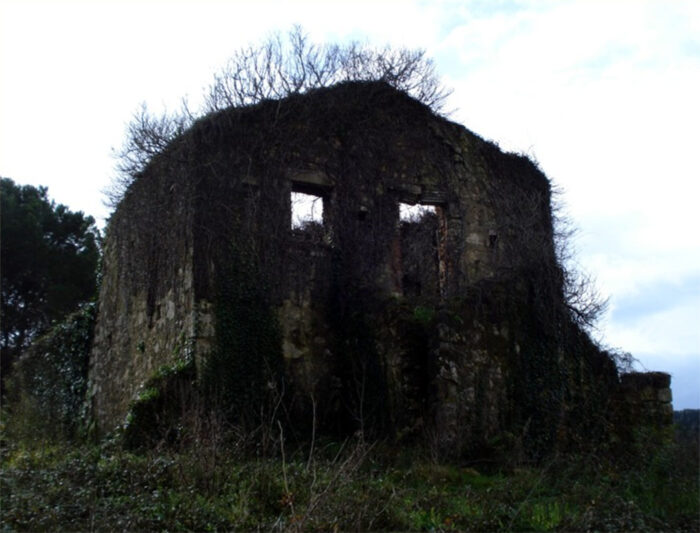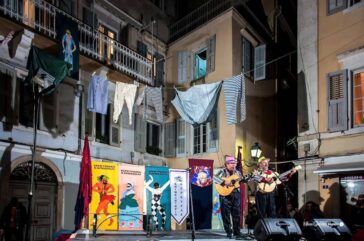Last updated on July 27th, 2024 at 02:04 pm
Hey there, let’s dive into a piece of history that might not be on everyone’s radar. Have you ever heard of Sagrado? No, not the restaurant in Corfu town, but a term that harkens back to Medieval and Venetian times. It’s like stepping into a hidden chapter of the past.
Alright, first things first. You might know the quaint Italian town of Sagrado, somewhere northeast of Venice and cozying up to the Slovenian border. And for those with a bit of linguistic flair, you’ll probably recognize that in Spanish, “Sagrado” translates to something sacred or holy – a touch of linguistic magic right there. But we’re not here to chat about restaurants or language lessons today.
We’re about to reveal a slice of Corfu’s past that’s not as well-known. Imagine, back when Corfu was under Venetian rule (that’s from 1386 to 1797), the upper crust had their hands on the reins of power, and let’s just say they weren’t exactly shy about using it. Those aristocratic families? They were practically the kings and queens of the island, calling the shots and making the rules.
Here’s the twist in this tale – each of these grand families had something called a “Sagrado” hiding away in their fancy mansions. And oh boy, these weren’t your regular hangout spots. Imagine an underground maze, narrow as can be, and deeper than your wildest imagination. A gallery of secrets, built from colossal stones, with only one way in and a double door that could lock it up tighter than a treasure chest.
Sometimes these Sagrados sat beneath the mansions, like quiet secrets kept beneath the floorboards. Other times, they stood alone, with arched entrances like portals to the unknown. There was even a sneaky hatch on some that led to the world above – talk about an escape route!

Now, this is where the drama unfolds. The nobles of the time weren’t exactly known for their kindness. In fact, they had a habit of treating regular folks like pawns on a chessboard. Think about it: your paycheck or your life – that was the choice many had to make.
Say a worker wanted what was rightfully his – his wages, his due. Well, that could be as good as signing a one-way ticket to oblivion. Imagine being summoned to the noble’s mansion, only to find yourself standing over that hatch we mentioned earlier. One swift push, and you’re in the depths of Sagrado, facing a slow and painful demise, often from hunger.
But it didn’t stop there. If you dared to cross a noble or posed a threat to their power, you could vanish into thin air – no one dared to look for you. And let’s talk about loans. If you borrowed money and couldn’t pay it back, the noble would call you in, pocket the money, and take your house while they were at it.
Crazy, right? Back then, there was only one rule that mattered: might make right. The powerful held all the cards, and the stories from those times are a mix of reality and maybe a sprinkle of exaggeration. But hey, it’s a glimpse into a world where power was unchecked, and the consequences were anything but ordinary.
The official claims for the use of Sagrado
Alright, gather ’round, because I’m about to spill the beans on some wild stories and intriguing mysteries surrounding Sagrado. You might think you know what these underground chambers were all about, but trust me, there’s more to it than meets the eye.
So, the official story goes like this: Sagrado was simply wine cellars or storage spaces. Imagine rows upon rows of wine barrels, aging gracefully in the cool underground. But then, there’s this other version – a bit spookier, might I add. Some folks believe that these places were more than just storage; they were catacombs, the final resting place for noble families. Talk about an eternal slumber, right?
Now, hold onto your hats, because there’s a legend in town, and it’s a real doozy.
Back in the days of Venetian rule, an institution popped up that changed the game, the hunted, criminals, and folks on the run had a golden ticket – the right to seek refuge in a noble’s mansion.
Yep, you heard that right. Imagine fleeing from the law and finding yourself standing at the gates of a fancy mansion. Before the cuffs could be slapped on, all you had to do was give that door knocker a gentle tap. Bam! You were now under the jurisdiction of the Conte – a noble’s authority.
Here’s the twist – if you committed minor shenanigans, you became the noble’s servant for life. No, seriously. You’re working off your “debt” while the noble sips wine in their mansion. But let’s say you were more of a hardcore criminal. Brace yourself, because Sagrado enters the scene. Those who crossed the line big time were locked away in these underground chambers. Imagine the cold stone walls as their only companions, a stark contrast to the world above.
Now, here’s where things get really juicy. This whole deal served a purpose. It was like a real-life scare tactic. Criminals meeting their fate in Sagrado sent a clear message to the troublemakers and poachers: “Hey, watch your step, or you’ll be the next guest in our underground hotel.” It’s like something out of a thriller novel.
Legend has it that only a handful of nobles, like Sordinas, Kourkoumelis, Androutselis, and Rivellis, held the power to offer asylum. But let’s be real – there were probably more than a few who had the key to the door of this twisted version of justice.
So, whether these chambers held wine or whispers of the past, there’s no denying that Sagrado’s story is a captivating mix of reality, legend, and a pinch of intrigue. Next time you wander through these historic corridors, remember the tales they hold and the secrets they guard.
The horrible reality
The Sagrado gained a terrible reputation, for they were, in fact, dark dungeons where criminals and/or innocents have died, so Sagrados were used as tools of fear for the people, and extermination tools for the nobles to accomplish their aims, very horrible and exceedingly myths were cultivated.

Alright, folks, brace yourselves, because we’re about to dive headfirst into the twisted tales of the Sagrado – a place where reality and horror blend into something straight out of a dark fantasy.
The Sagrado, once deemed as a simple storage space or perhaps catacombs for nobles, actually held a much darker secret. These weren’t just ordinary chambers; they were dungeons, deep and ominous, where shadows whispered the tales of lives cut short. And let me tell you, the reputation they gained was nothing short of bone-chilling.
Here’s the deal: these Sagrados weren’t just spaces; they were tools of fear, wielded by the nobles to exert their power over the people. Imagine being marked for a journey into these dark depths – your fate sealed, your cries unheard. These chambers weren’t merely hidden; they were the stuff of nightmares, a place where lives were extinguished and myths cultivated to extremes.
Now, here’s where it gets hair-raising. While we can’t verify every myth spun about the Sagrado, there’s a truth lingering in the shadows. Those nobles, hungry to preserve their power and eliminate threats, didn’t flinch at crossing lines. No matter how exaggerated the stories might be, the core truth remains: the Sagrado served as a chilling reminder of the lengths people would go to protect their privileges.
Fast forward to a darker time – the Axis forces occupied Corfu during the tumultuous years. And guess what? They stumbled upon the secrets these chambers held. They pried open sealed entrances and found human skeletons, devoid of coffins, scattered as if the very ground was haunted. The truth stared them in the face: this wasn’t the sanctuary of a noble family; it was a graveyard of the forgotten.
So let’s sum it up: the Sagrado wasn’t just a historical curiosity. It was a chilling tale of power unchecked, of lives lost, and of horrors lurking beneath the surface. Whether it was the ruthless nobles of old or the stark realities of wartime occupation, the Sagrado became a testament to the darkness that can hide behind even the most seemingly innocent spaces.
More about Corfu
Festivals and Panigiria in the Villages of Corfu
Experience authentic Corfiot culture at traditional village festivals (panigiria) with local food, music, and heartfelt celebrations year-round.
Gossip with a Twist: Corfu’s Petegoletsa Tradition
On the last Thursday of the carnival, Corfu has revived a very old tradition, an integral part of the Corfu carnival, which dates from the years of Venetian rule. It is called the Petegoletsa.
Corfu Carnival: Echoes of a Venetian Past
The Ancient celebrations in early spring that took place in honor of Dionysus, god of wine and fun, hoping for a good harvest and successful husbandry, are the forerunners of today’s carnival in Greece.
What is Corfu best known for?
Beyond its natural beauty, what is Corfu famous for? as a melting pot of various civilizations, is famous for its architecture, traditions, and cuisine.
Corfu Musical Tradition – Literature and Intellectuals
Corfu’s rich cultural heritage features a strong musical and literary traditions that continue to shape the island’s cultural identity until today.
Melodic Corfu: A Symphony of Culture, Music, and Beauty
Corfu, the musical heart of Greece, where the very air seems to harmonize with the soulful sounds of music when musical charm doesn’t stop at instruments and performances only.











Comments